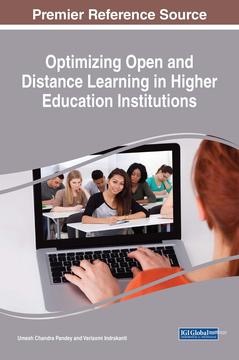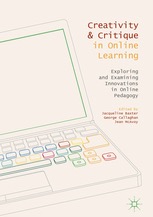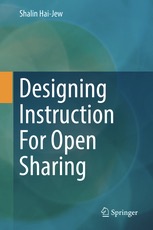online education
Select an item by clicking its checkbox
Date Reviewed: June 21, 2021
This textbook considers and addresses the design of online learning objects, electronic textbooks, short courses, long courses, MOOC courses, and other types of contents for open sharing. It also considers the design of online mediated communities to enhance such learning. The “openness” may be open-access, and/or it may even be open-source. The learning may range from self-directed and automated to AI robot-led to instructor-led.
The main concept of this work is that design learning for open sharing, requires different considerations than when designing for closed and proprietary contexts. Open sharing of learning contents requires a different sense of laws (intellectual property, learner privacy, pedagogical strategies, technologies, media, and others). It requires different considerations of learner diversity and inclusion. It requires geographical, cultural, and linguistic considerations that are not as present in more localized designs. The open sharing aspect also has effects on learner performance tracking (assessments) and learner feedback.
This textbook targets students, both undergraduate and graduate in computer science, education and other related fields. Also, professionals in this field managing online systems would find this book helpful. (From the Publisher)

Optimizing Open and Distance Learning in Higher Education Institutions
Date Reviewed: January 18, 2019
What impact does education have upon a nation’s economy? Can education be used as a global instrument to overcome obstacles and foster change? These are just a few of the pivotal questions discussed throughout this resource that targets researchers and educators alike by introducing them to new theories and research concepts. This resource’s scholarly references and figures provide a broad perspective on trends and standards in higher education. The collection examines developing areas across the globe, the impact of initiatives on nations’ standings, and the connection between knowledge, economy, and technological capabilities in society. More importantly, this publication provides solutions for optimizing open and distance learning in higher education. It explores various developing nation’s policies regarding distance and open learning programs, obstacles and opportunities in higher education, as well as technological sustainability.
Optimizing Open and Distance Learning in Higher Education Institutions discusses how the “United Nations Development Programme (UNDP) creates policies for leadership skills, partnerships, and sustainable development” in developing areas (UNESCO, 2015). The research recognizes education as a global tool for tackling challenges and achieving change based on policies. It describes how development policies encourage higher education institutions to uniquely customize open and distance learning to suit individual growth needs and explains how customization then allows flexibility that combats cultural and socio-economic barriers. In developing nations, where continual changes in education and training rely upon such adaptability in education, open and distance learning can help to stabilize the economy and create a solid infrastructure.
Global cooperation creates a new dimension of challenges and opportunities in higher education. Learners are exposed to new techniques to improve skills and gain knowledge through open and distance learning by shifting toward learner-centered education and self-directed learning. Various contributors from around the globe form a fluid collection of writing grounded in research specific to open learning, distance learning, and e-learning.
This reference is highly recommended for researchers, educators, and students who seek to advance technology and education globally. This work explores gaps in theory and practice and offers recommendations for improvement. The different chapters analyze: e-learning, open and distance learning and education, higher education, quality assurance, trends, sustainability, and integration. Subtopics identify the services provided, access to education, management and capacity, technology equality, knowledge-based development, and sustainable growth in education. Further themes stress limitations, acquisition of “on the job” training components needed for employment, skills and technical proficiencies, and policy and research for technology integration. The collection not only details open and distance learning in higher education institutions in developing nations and efforts to overcome certain restrictions, but also creates polices for an educational path forward to reach goals of equality and sustainability.

Creativity & Critique in Online Learning: Exploring and Examining Innovations in Online Pedagogy
Date Reviewed: December 13, 2018
The growth of online education prompts a need for qualitative research about student learning outcomes and teaching methodologies. It also requires the production of specific educational material that is consonant with this educational medium. In addition, practical advice for online educational methods is warranted. This book is a collection of articles that address a range of concerns within online education. The authors do a good job in the critical assessment of the current possibilities that online education provides. It also invites readers to engage in complex discussions about online education in the future.
Creativity and Critique in Online Learning is divided into two parts. The first part is concerned with teaching practices. In particular, it examines available online teaching instruments and places online education in a broader context. This section of the book contributes a detailed analysis of online forums, discusses ways to make online teams work effectively, and explores how popular social networks, such as Facebook, contribute to informal learning. It also discusses what role multisensory learning has in online space, how to use all the senses in online education, as well as how to nurture creativity and critical assessment. This section is of interest to teachers and students alike because it looks at practical aspects of online education and gives useful advice on how to use them productively.
The second part of the book focuses on particular online teaching challenges and how to effectively engage them. Online academic cheating, its growth, and various ways to fight this phenomenon are addressed. In addition, it provides help for how to build successful relationships, instill values, and cherish identity in the online teaching community. This section also takes a closer look at massive open online courses and their drawbacks, both explicit and implicit. One of the most interesting articles in this part is “The Move to Online Teaching: A Head of Department’s Perspective” by Diane Preston. This chapter invites readers to examine online education through the eyes of an experienced educator who is concerned about both the teaching process and institutional concerns.
Overall, Creativity and Critique in Online Learning is recommended for a broad audience of educators. It contains useful information for teachers who are currently involved in online teaching, scholars, and policymakers in online education, as well as teachers practicing a traditional form of education and looking for interesting and innovative ways to make their subjects more appealing to contemporary students. One of the main pros of this book is that it does not try to present online education as a modern teaching panacea or the only choice for education in the future. On the contrary, the book presents online teaching in an unbiased manner. While it certainly praises the advantages and possibilities online education has for all participants of the teaching process, it also reveals existing flaws and addresses specific dangers of online education.
We can boil successful strategic planning around distance education down to three things. First, know how to create lots of ways to use the digital environment for effective teaching and learning. Second, know your potential students. Third, bring the two together: develop a set of scenarios in which to leverage ...

Using Entertainment–Education for Distance Education, 2nd Edition (Communication for Behavior Change Volume lll)
Date Reviewed: January 25, 2018
As a professor who teaches in an online education program, I picked up this book with interest for how it might inform my pedagogy. The content of the book, while relevant to my context of theological education, addresses more specifically the needs of organizations working for behavioral change in developing countries, particularly regarding available health interventions such as disease testing and immunizations. The authors address the mediums of radio, television, and internet, and how managers of these educational programs can best utilize different types of information sources.
Early on, the authors distinguish between “Edu-tainment” and “Entertainment-Education.” Edu-tainment is a focus on education that employs insights from entertainment to keep learners engaged in the educational process and content. Entertainment-Education relies more heavily on the entertainment side in order to teach a certain topic or attitude, helping participants to empathize with characters in order to consider adopting behaviors similar to the characters. Entertainment-Education might look like a fable told to convey a moral – the story of the fable is interesting in itself, while the moral being taught is present but not foregrounded. With Edu-tainment, the same moral or lesson is present as in the fable, but the lesson or intended learning outcome is more directly named.
While the title of the book contains “Entertainment-Education,” “Edu-tainment” is the main focus of the authors. Both approaches appeal to the “E Structure,” which is “Engagement of the audience, through Emotional involvement, which inspires Empathy for certain characters, who then provide Examples that demonstrate to the audience how they can accomplish the desired behavior, and also provide a sense of Efficacy for audience members, who make the desired changes or acquire that desired knowledge and gain a degree of Ego-enhancement (personal growth)” (8).
Excellence in Edu-tainment requires a great deal of management and collaboration. The authors describe the various formats for Edu-tainment such as video or radio, and how the eventual product should be constructed with a team of writers, producers, and actors, with how lessons should be piloted with control groups to judge their effectiveness. Persons reading this for the sake of improving their online education pedagogy will feel overwhelmed by the expectations here, but learning about the possibilities for dramatic renderings of lessons with scripted dialogue can provide new ways to think about teaching for those interested in deepening their skills. While this book may not be directly helpful to theological educators because of its emphasis on behavioral modification in developing countries, it does provide some helpful tips.

